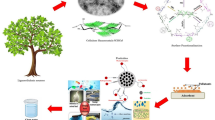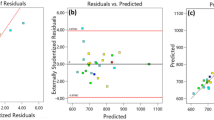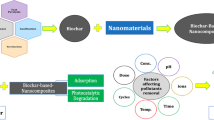Abstract
In the aim of textile printing and dyeing wastewater efficient and environmental friendly treatment, a cross-linked grafted cationic starch flocculant (CGSt) was prepared to study its removal performance of textile dyes. Here in, corn starch (St) was used as raw material, methacryloyloxyethyl trimethyl ammonium chloride and N.N′-methylenebisacrylamide were used as cationization grafting monomer and crosslinking monomer, respectively, and an environmentally friendly Fenton initiation system was adopted. The chemical structure and physicochemical properties of CGSt were characterized FTIR, NMR, XPS, EDS, XRD and SEM. The flocculation performance of CGSt on acid light yellow G, direct lake blue 5B and reactive brilliant blue KE-GN was investigated. The removal rate (RR) of CGSt to acid light yellow G, reactive brilliant blue KE-GN and direct lake blue 5B reaches 97.2%, 96.3% and 97.2%, respectively. CGSt has a wide flocculation window from 5 g/L to 12 g/L. It maintains good flocculation performance in a wide pH range from 4 to 9, and the RR was the highest when pH was 9, which is beneficial for the treatment of textile printing and dyeing wastewater with high alkalinity, complex composition and variable water quality by CGSt.










Similar content being viewed by others
Data availability
All data generated or analysed during this study are included in this published article.
References
Verma AK, Dash RR, Bhunia P (2012) A review on chemical coagulation/flocculation technologies for removal of colour from textile wastewaters. J Environ Manage 93(1):154–168
Prus S, Kulpinski P, Matyjas-Zgondek E et al (2022) Eco-friendly dyeing of cationised cotton with reactive dyes: mechanism of bonding reactive dyes with CHPTAC cationised cellulose. Cellulose 29(7):4167–4182
Vuckovic N, Nikodijevic M, Djordjevic D (2021) the study of direct dye sorption on flax fibers during dyeing. Chem Ind Chem Eng Q 27(3):255–263
Akhtar Z, Ali SI, Ali SR et al (2019) Synthesis, characterization and dyeing assessment of novel acid dyes on wool fabric IV. J Chem Soc Pak 41(4):633–639
Srivastava A, Rani RM, Patle DS et al (2022) Emerging bioremediation technologies for the treatment of textile wastewater containing synthetic dyes: a comprehensive review. J Chem Technol Biotechnol 97(1):26–41
Uddin F (2021) Environmental hazard in textile dyeing wastewater from local textile industry. Cellulose 28(17):10715–10739
Leal CS, Mesquita DP, Amaral AL et al (2020) Environmental impact and biological removal processes of pharmaceutically active compounds: the particular case of sulfonamides, anticonvulsants and steroid estrogens. Crit Rev Environ Sci Technol 50(7):698–742
Liu NN, Wu YH, Sha HT (2018) Characterization of EDTA-cross-linked beta-cyclodextrin grafted onto Fe-Al hydroxides as an efficient adsorbent for methylene blue. J Colloid Interface Sci 516:98–109
Soto D, Leon O, Munoz-Bonilla A et al (2021) Succinylated starches for dye removal. Starch-Starke. https://doi.org/10.1002/star.202000043
Donkadokula NY, Kola AK, Naz I et al (2020) A review on advanced physico-chemical and biological textile dye wastewater treatment techniques. Rev Environ Sci and Bio-Technol 19(3):543–560
Mohapatra DP, Kirpalani DM (2019) Selenium in wastewater: fast analysis method development and advanced oxidation treatment applications. Water Sci Technol 79(5):842–849
Sharma A, Ahmad J, Flora SJS (2018) Application of advanced oxidation processes and toxicity assessment of transformation products. Environ Res 167:223–233
Sivagami K, Sakthivel KP, Nambi IM (2018) Advanced oxidation processes for the treatment of tannery wastewater. J Environ Chem Eng 6(3):3656–3663
Ni HC, Arslan M, Wei J et al (2021) Treatment of printing and dyeing wastewater in biological contact oxidation reactors comprising basalt fibers and combination fillers as bio-carriers: elucidation of bacterial communities and underlying mechanisms. Sci Total Environ 785:147272
Patel D, Bapodra SL, Madamwar D et al (2021) Electroactive bacterial community augmentation enhances the performance of a pilot scale constructed wetland microbial fuel cell for treatment of textile dye wastewater. Biores Technol 332:125088
Cheng H, Liu YL, Li X (2021) Adsorption performance and mechanism of iron-loaded biochar to methyl orange in the presence of Cr6+ from dye wastewater. J Hazard Mater 415:125749
Song JZ, Li Y, Wang Y et al (2021) Preparing biochars from cow hair waste produced in a tannery for dye wastewater treatment. Materials 14(7):1690
Wang KX, Liu HF, Wang YT et al (2022) Study on the flocculation performance of a cationic starch-based flocculant on humic substances in textile dyeing wastewater. Starch-Starke. https://doi.org/10.1002/star.202100232
Lapointe M, Barbeau B (2020) Understanding the roles and characterizing the intrinsic properties of synthetic vs. natural polymers to improve clarification through interparticle bridging: a review. Sep Purif Technol 231:115893
Liu ZG, Lu X, Xie JK et al (2019) Synthesis of a novel tunable lignin-based star copolymer and its flocculation performance in the treatment of kaolin suspension. Sep Purif Technol 210:355–363
Peng SL, Jiang GC, Li XL et al (2018) Synthesis, characterization and evaluation of amphoteric chitosan-based grafting flocculants for removing contaminants with opposite surface charges from oilfield wastewater. J Chem Technol Biotechnol 93(4):968–974
Salehizadeh H, Yan N, Farnood R (2018) Recent advances in polysaccharide bio-based flocculants. Biotechnol Adv 36(1):92–119
Zhang WX, Wang XJ, Xu Q et al (2020) Synthesis of lignosulfonate-acrylamide-dimethyldiallylammonium chloride copolymer and its flocculation performance. J Appl Polym Sci. https://doi.org/10.1002/app.48560
Liu YL, Li C, Lou ZM et al (2021) Antimony removal from textile wastewater by combining PFS&PAC coagulation: enhanced Sb(V) removal with presence of dispersive dye. Sep Purif Technol 275:119037
Vergili I, Gencdal S (2017) Removal of organic matter and etodolac from pharmaceutical industry wastewater by PAC adsorption. Water Environ Res 89(7):641–651
Gu SG, Lian F, Yan KJ et al (2019) Application of polymeric ferric sulfate combined with cross-frequency magnetic field in the printing and dyeing wastewater treatment. Water Sci Technol 80(8):1562–1570
Lu HY, Qian CY, Luo SG et al (2023) Study on the influence and mechanism of polyferric sulfate on COD removal and reuse of scheelite flotation wastewater. Miner Eng 191:107940
Luo XG, Li XB, Wei C et al (2021) Use of carbon dioxide to enhance the brine purification and flocculation performance of PAM flocculants. Sep Purif Technol 267:118676
Qi GX, Wang XB, Shen Y et al (2022) Effect of different flocculants on the characteristics of hydrochar and hydroliquid derived from the hydrothermal treated active sludge. A comparative study. J Environ Chem Eng 10(3):107514
Abdollahi Z, Frounchi M, Dadbin S (2011) Synthesis, characterization and comparison of PAM, cationic PDMC and P(AM-co-DMC) based on solution polymerization. J Ind Eng Chem 17(3):580–586
Chen XD, Wang DF, Wang S et al (2021) Synthesis and dewatering properties of cellulose derivative-grafting DMC amphoteric biodegradable flocculants. J Polym Environ 29(2):565–575
Nasim T, Bandyopadhyay A (2012) Introducing different poly (vinyl alcohol)s as new flocculant for kaolinated waste water. Sep Purif Technol 88:87–94
Nasim T, Pal A, Bandyopadhyay A (2018) Flocculation of aqueous kaolin suspension using a biodegradable flocculant system of poly (vinyl alcohol)-acacia nilotica gum blends. Appl Clay Sci 152:83–92
Koshani R, Tavakolian M, De Ven T (2020) Cellulose-based dispersants and flocculants. J Mater Chem B 8(46):10502–10526
Song YF, Hu QH, Li TM et al (2020) Advanced reclamation of hairwork dyeing effluent using tree-shaped cellulose flocculants and subsequent optimization of dual-membrane performance and fouling behavior. J Clean Prod 268:122348
Asharuddin SM, Othman N, Altowayti WAH et al (2021) Recent advancement in starch modification and its application as water treatment agent. Environ Technol Innov 23:101637
Liu W, Ma JJ, Pang HJ et al (2021) Synthesis of a polyamine-modified starch flocculant and its application. Iran Polym J 30(7):675–683
Hu P, Shen SH, Yang H (2021) Evaluation of hydrophobically associating cationic starch-based flocculants in sludge dewatering. Sci Rep. https://doi.org/10.1038/s41598-021-91323-y
Luo YL, Lin JL, Wang XT et al (2023) Study on flocculation performance of new cationic starch-based sludge wastewater flocculant. Starch-Starke. https://doi.org/10.1002/star.202200226
Wu YY, Jiang JY, Sun Q et al (2022) Efficient removal of both positively and negatively charged colloidal contaminants using amphoteric starch-based flocculants synthesized by low-pressure UV initiation. Sep Purif Technol 282:120120
Jiang YX, Ju BZ, Zhang SF et al (2010) Preparation and application of a new cationic starch ether-Starch-methylene dimethylamine hydrochloride. Carbohyd Polym 80(2):467–473
Chen Y, Tian GW, Zhai BY et al (2019) Cationic starch-grafted-cationic polyacrylamide based graphene oxide ternary composite flocculant for the enhanced flocculation of oil sludge suspension. Compos Part B-Eng 177:107416
Zhou L, Zhou HJ, Yang XY (2019) Preparation and performance of a novel starch-based inorganic/organic composite coagulant for textile wastewater treatment. Sep Purif Technol 210:93–99
Zhou HJ, Zhou L, Yang XY (2018) Optimization of preparing a high yield and high cationic degree starch graft copolymer as environmentally friendly flocculant: Through response surface methodology. Int J Biol Macromol 118:1431–1437
Hu P, Xi ZH, Li Y et al (2020) Evaluation of the structural factors for the flocculation performance of a co-graft cationic starch-based flocculant. Chemosphere 240:124866
Lou T, Cui GP, Xun JJ et al (2018) Synthesis of a terpolymer based on chitosan and lignin as an effective flocculant for dye removal. Colloids Surf Physicochem Eng Asp 537:149–154
Kumar N, Mittal H, Alhassan SM et al (2018) Bionanocomposite hydrogel for the adsorption of dye and reusability of generated waste for the photodegradation of ciprofloxacin: a demonstration of the circularity concept for water purification. Acs Sustain Chem Eng 6(12):17011–17025
Hernandez-Martinez AR, Lujan-Montelongo JA, Silva-Cuevas C et al (2018) Swelling and methylene blue adsorption of poly(N, N-dimethylacrylamide-co-2-hydroxyethyl methacrylate) hydrogel. React Funct Polym 122:75–84
Wei YX, Ding AM, Chen YY (2023) A novel titanium sulfate modified poly-magnesium-silicate coagulant with improved pH range for dye removal. J Environ Manag 343:118168
Wu H, Liu ZZ, Li AM et al (2017) Evaluation of starch-based flocculants for the flocculation of dissolved organic matter from textile dyeing secondary wastewater. Chemosphere 174:200–207
Arayaphan J, Maijan P, Boonsuk P et al (2021) Synthesis of photodegradable cassava starch-based double network hydrogel with high mechanical stability for effective removal of methylene blue. Int J Biol Macromol 168:875–886
Wu H, Liu ZZ, Yang H et al (2016) Evaluation of chain architectures and charge properties of various starch-based flocculants for flocculation of humic acid from water. Water Res 96:126–135
Li T, Zhu Z, Wang DS et al (2006) Characterization of floc size, strength and structure under various coagulation mechanisms. Powder Technol 168(2):104–110
Wang YJ, Zhang YJ (2022) Flocculation performance evaluation and flocculation mechanism study of PAC/PMAPTAC composite flocculant in dyeing wastewater. Desalin Water Treat 268:138–145
Funding
This work was supported by the National Key R&D Program of China (2023YFE0101000), Key R&D Program of Shandong Province (2022CXGC020416).
Author information
Authors and Affiliations
Contributions
HZ: reviewing and editing. JL: conceptualization, writing-original draft preparation and methodology. SC: auxiliary experiments. YD: auxiliary experiments. NC, HW: supervision and funding.
Corresponding authors
Ethics declarations
Competing Interests
No, I declare that the authors have no competing interests as defined by Springer, or other interests that might be perceived to influence the results and/or discussion reported in this paper.
Additional information
Publisher's Note
Springer Nature remains neutral with regard to jurisdictional claims in published maps and institutional affiliations.
Supplementary Information
Below is the link to the electronic supplementary material.
Rights and permissions
Springer Nature or its licensor (e.g. a society or other partner) holds exclusive rights to this article under a publishing agreement with the author(s) or other rightsholder(s); author self-archiving of the accepted manuscript version of this article is solely governed by the terms of such publishing agreement and applicable law.
About this article
Cite this article
Zhang, H., Li, J., Cao, S. et al. Preparation of Crosslinking-Grafting Cationic Starch Flocculant and Its Study on Textile Dyes Removal. J Polym Environ (2024). https://doi.org/10.1007/s10924-023-03133-0
Accepted:
Published:
DOI: https://doi.org/10.1007/s10924-023-03133-0




